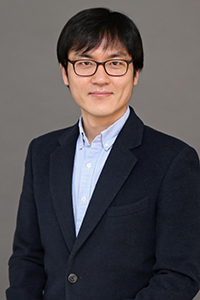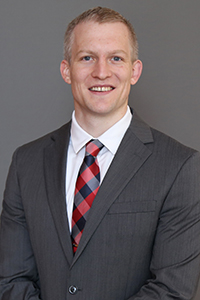Honoring faculty from a wide variety of fields of study, Brown University presented Research Achievement Awards to seven professors in its annual program to honor exceptional scholars across a wide variety of disciplines. Engineering Assistant Professor Anita Shukla received an Early Career Research Achievement Award for her work focusing on designing responsive and targeted biomaterials for applications in drug delivery and regenerative medicine.
 Shukla has done considerable work to treat infections, including development of bacteria- and fungi-degradable hydrogels to control resistance and toxicity. She is the recipient of a number of awards, including a Presidential Early Career Award for Scientists and Engineers, a National Science Foundation CAREER Award and an Office of Naval Research Director of Research Early Career Grant.
Shukla has done considerable work to treat infections, including development of bacteria- and fungi-degradable hydrogels to control resistance and toxicity. She is the recipient of a number of awards, including a Presidential Early Career Award for Scientists and Engineers, a National Science Foundation CAREER Award and an Office of Naval Research Director of Research Early Career Grant.
“It is a great pleasure to recognize the singular accomplishments of these seven researchers,” said Vice President for Research Jill Pipher. “Beyond their exceptional achievements, these awards are also about something larger — Brown is truly making a difference in the world, through both fundamental and translational research.”
Brown Provost Richard M. Locke said the scholars — whose fields of study range from pediatrics to engineering to computer science to the visual arts — illustrate the kind of high-impact research that takes place in the field and in laboratories across the Brown campus.
“With its culture of collaboration and excellence, Brown is uniquely positioned to address critical societal issues through rigorous research, teaching and service,” Locke said. “Our faculty are central to these efforts. Research helps us understand and mitigate great challenges, and this year’s award winners are outstanding examples of this.”
Nominations for the awards were sought in several categories and reviewed by panels of distinguished Brown faculty. In addition to the awards, each winner received a $5,000 research stipend. Brown’s annual Celebration of Research event was postponed due to the COVID-19 crisis, and a program paying tribute to winners will be held at a later date. The other six winners of the 2020 Research Achievement Awards included: Pediatrics’ Silvia Chiang (Early Career Research Award), Molecular Pharmacology, Physiology and Biotechnology’s Nicolas Fawzi (Early Career Research Award), Computer Science’s Michael Littman (Distinguished Research Achievement Award), Alcohol and Addiction Studies’ Peter Monti (Distinguished Research Achievement Award), Visual Arts’ RaMell Ross (Early Career Research Award) and Molecular Biology, Cell Biology and Biochemistry’s John Sedivy (Distinguished Research Achievement Award).
The Research Achievement Awards are one of a number of Brown programs that recognize the importance of research by Brown faculty. Sixteen teams of Brown faculty were awarded 2020 Research Seed Awards, given to support the generation of preliminary data and pursuit of new research directions or collaborations.
Both Professor Iris Bahar, who is investigating “Smarter AI: Designing Autonomous Systems that Optimize Hardware, Software and Cognitive Components Together” and Assistant Professor Jonghwhan Lee, who is studying “Computational Modeling of Blood Flow to Understand Microvascular Dysfunction in Alzheimer's Disease,” were Research Seed Award winners in the Biological, Life, and Physical Sciences category.
Seventeen winners were named for 2020 Salomon Awards, which recognize excellence in scholarship, with preference given to junior faculty. Among those 17, four Engineering junior faculty members were winners, including Assistant Professor Jesse Ault (“Non-equilibrium molecular dynamics simulations of protein diffusiophoresis for biomedicine”), Assistant Professor (Research) Farah Laiwalla (“High-Resolution 3-D Access to the Brain through Multi-Site Complex Probe Architectures”), Assistant Professor Dan Harris (“Tailoring Taylor Dispersion for Microfluidic Applications”) and Assistant Professor Vikas Srivastava (“Bio-inspired Novel Hydrogel Architecture for Energy Harvesting”).
Following are the description of the engineering-affiliated projects funded by the 2020 Research Seed and Salomon awards:
Research Seed Award for Biological, Life and Physical Sciences
Smarter AI: Designing Autonomous Systems that Optimize Hardware, Software and Cognitive Components Together
 Iris Bahar: Deep learning (e.g., convolutional neural networks (CNNs)) has gained a lot of attention in the past few years, especially for object identification and classification problems. Despite their strengths, CNNs have several shortcomings, such as their opacity to understand how they make decisions, fragility for generalizing beyond overfit training examples, and inability to recover from bad decisions. These weaknesses play to the strengths of techniques in artificial intelligence (AI) based on generative probabilistic inference, techniques that are inherently explainable, general, and resilient by distribution of many hypotheses representing possible decisions. Unfortunately, probabilistic inference, in contrast to CNNs, is often computationally intractable with complexity that grows exponentially with the number of variables. Combined discriminative-generative algorithms have been proposed as a promising avenue for robust perception by balancing computational complexity with explainability and reasoning, but still may not provide for real-time response, even after careful optimization. Instead, we propose bringing humans back into the loop to provide essential functionality to guide decisions, planning, and management of an AI-enhanced system. In particular, the models that have proven useful for understanding human agency are Causal Bayes Nets. This project seeks to explore how humans and intelligent computers can collaborate effectively by integrating technical functions (i.e., discriminative-generative decision making) with human cognitive processes. A driving theme of this exploration will be complexity (and energy) optimization. Applying more effort and thereby computational and cognitive assistance in a hybrid fashion, and only as needed, will minimize energy consumption, improve response time, and be more likely to optimize users’ needs.
Iris Bahar: Deep learning (e.g., convolutional neural networks (CNNs)) has gained a lot of attention in the past few years, especially for object identification and classification problems. Despite their strengths, CNNs have several shortcomings, such as their opacity to understand how they make decisions, fragility for generalizing beyond overfit training examples, and inability to recover from bad decisions. These weaknesses play to the strengths of techniques in artificial intelligence (AI) based on generative probabilistic inference, techniques that are inherently explainable, general, and resilient by distribution of many hypotheses representing possible decisions. Unfortunately, probabilistic inference, in contrast to CNNs, is often computationally intractable with complexity that grows exponentially with the number of variables. Combined discriminative-generative algorithms have been proposed as a promising avenue for robust perception by balancing computational complexity with explainability and reasoning, but still may not provide for real-time response, even after careful optimization. Instead, we propose bringing humans back into the loop to provide essential functionality to guide decisions, planning, and management of an AI-enhanced system. In particular, the models that have proven useful for understanding human agency are Causal Bayes Nets. This project seeks to explore how humans and intelligent computers can collaborate effectively by integrating technical functions (i.e., discriminative-generative decision making) with human cognitive processes. A driving theme of this exploration will be complexity (and energy) optimization. Applying more effort and thereby computational and cognitive assistance in a hybrid fashion, and only as needed, will minimize energy consumption, improve response time, and be more likely to optimize users’ needs.
PI: R. Iris Bahar, Professor of Computer Science, Professor of Engineering
Co-PI: Steven Sloman, Professor of Cognitive, Linguistic and Psychological Sciences
Key Personnel: Odest Chadwicke Jenkins, Associate Professor of Computer Science, University of Michigan, Ann Arbor
Funded: $76,000
Computational Modeling of Blood Flow to Understand Microvascular Dysfunction in Alzheimer's Disease
 Jongwhan Lee: Alzheimer’s disease (AD), a progressive neurodegenerative disorder affecting millions of people worldwide, and related dementia are becoming the biggest epidemic in medical history. However, AD is a heterogeneous and multifactorial disease, making it challenging to fully understand how the multiple etiologies and age-related prodromal processes in AD contribute to its pathophysiology. Among other factors, deficits in cerebral microvascular structures and functions are recently considered to play a key role in the onset and development of AD. But, it is still unclear whether they are a causal factor for AD pathogenesis or an early consequence of multifactorial conditions that lead to AD at a later stage, despite its importance for early diagnosis and as a therapeutic target. To address this knowledge gap, we performed a longitudinal imaging experiment of tracking progressive microvascular alterations in AD mice for almost their lifespan. Although these data provide us with unprecedentedly rich information about various cerebral microvascular deficits and cognitive impairment, they were insufficient to determine the cause-effect relationships. Here, in this Seed project we will develop a computational methodology to investigate the mechanistic question. First, we will improve our computational model of microvascular flow and functional hyperemia (Aim 1), and then combine the model with the experimental data for the mechanistic study (Aim 2). The computational model will enable us to essentially “turn on” and “turn off” each microvascular deficit (e.g., thinner vessels, tortuous capillaries, hypoperfusion) and test its effect on oxygen delivery to neurons, which is difficult and sometimes impossible to achieve experimentally.
Jongwhan Lee: Alzheimer’s disease (AD), a progressive neurodegenerative disorder affecting millions of people worldwide, and related dementia are becoming the biggest epidemic in medical history. However, AD is a heterogeneous and multifactorial disease, making it challenging to fully understand how the multiple etiologies and age-related prodromal processes in AD contribute to its pathophysiology. Among other factors, deficits in cerebral microvascular structures and functions are recently considered to play a key role in the onset and development of AD. But, it is still unclear whether they are a causal factor for AD pathogenesis or an early consequence of multifactorial conditions that lead to AD at a later stage, despite its importance for early diagnosis and as a therapeutic target. To address this knowledge gap, we performed a longitudinal imaging experiment of tracking progressive microvascular alterations in AD mice for almost their lifespan. Although these data provide us with unprecedentedly rich information about various cerebral microvascular deficits and cognitive impairment, they were insufficient to determine the cause-effect relationships. Here, in this Seed project we will develop a computational methodology to investigate the mechanistic question. First, we will improve our computational model of microvascular flow and functional hyperemia (Aim 1), and then combine the model with the experimental data for the mechanistic study (Aim 2). The computational model will enable us to essentially “turn on” and “turn off” each microvascular deficit (e.g., thinner vessels, tortuous capillaries, hypoperfusion) and test its effect on oxygen delivery to neurons, which is difficult and sometimes impossible to achieve experimentally.
PI: Jongwhan Lee, Assistant Professor of Engineering
Funded: $49,000
Research Salomon Award for Biological, Life and Physical Sciences
Non-equilibrium molecular dynamics simulations of protein diffusiophoresis for biomedicine
 Jesse Ault: Investigating the conformational and global dynamics of proteins using molecular dynamics (MD) simulations is a critical focus area in computational biology. However, most MD simulations of proteins are currently performed under equilibrium conditions, whereas biological proteins typically exist in the presence of chemical concentration gradients, which affect protein dynamics through electrokinetic and steric interactions. Non-equilibrium MD simulations are impractical with most standard simulation packages, because the wide-spread use of periodic boundary conditions drives the dynamics toward equilibrium, and non-equilibrium phenomena of interest often occur on long time scales. In this project, we propose to overcome these challenges by implementing novel force models in the boundary regions of MD simulations to drive the dynamics toward predictable non-equilibrium states. We will use these tools to simulate the protein dynamics in solute concentration gradients and characterize the role of protein/solute interactions on the conformational and global dynamics of proteins. Ultimately, the development of these methods and tools will facilitate new investigations into the non-equilibrium global and conformational dynamics of single- and multi-protein systems, with potential applications to protein phase separation and the formation of membraneless organelles. The tools and research proposed here have broad applications to quantitative and computational biology, especially towards advancing our understanding of the role of non-equilibrium processes on protein dynamics and aggregation that critically contribute towards cell physiology and disease. Furthermore, this research will facilitate the development of new biomedical technologies and applications involving the selective control and measurement of multi-protein systems, such as protein detection, sorting, and pre-concentration.
Jesse Ault: Investigating the conformational and global dynamics of proteins using molecular dynamics (MD) simulations is a critical focus area in computational biology. However, most MD simulations of proteins are currently performed under equilibrium conditions, whereas biological proteins typically exist in the presence of chemical concentration gradients, which affect protein dynamics through electrokinetic and steric interactions. Non-equilibrium MD simulations are impractical with most standard simulation packages, because the wide-spread use of periodic boundary conditions drives the dynamics toward equilibrium, and non-equilibrium phenomena of interest often occur on long time scales. In this project, we propose to overcome these challenges by implementing novel force models in the boundary regions of MD simulations to drive the dynamics toward predictable non-equilibrium states. We will use these tools to simulate the protein dynamics in solute concentration gradients and characterize the role of protein/solute interactions on the conformational and global dynamics of proteins. Ultimately, the development of these methods and tools will facilitate new investigations into the non-equilibrium global and conformational dynamics of single- and multi-protein systems, with potential applications to protein phase separation and the formation of membraneless organelles. The tools and research proposed here have broad applications to quantitative and computational biology, especially towards advancing our understanding of the role of non-equilibrium processes on protein dynamics and aggregation that critically contribute towards cell physiology and disease. Furthermore, this research will facilitate the development of new biomedical technologies and applications involving the selective control and measurement of multi-protein systems, such as protein detection, sorting, and pre-concentration.
PI: Jesse Ault, Assistant Professor of Engineering
Funded: $15,000
High-Resolution 3-D Access to the Brain through Multi-Site Complex Probe Architectures
 Farah Laiwalla: The goal of this project is to address key challenges for contemporary chronically implanted neurotechnologies through innovative design and use of complex, integrated 3-D probe architectures enabling enhanced, scalable spatial access to the brain while limiting implant size and invasiveness. In contrast to traditional approaches obtaining at best, two-dimensional access to neural signals from the cortex, we aim to engineer in this project, a cortical probe platform enabling high-density and high-resolution, three-dimensional access to large cortical volumes. We propose to leverage advanced microfabrication techniques to directly integrate 3-D “microneedle” probes with high-performance, integrated electronic chips for measuring and modulating neural activity, thereby eliminating the need for tedious and failure-prone interconnects. Additionally, we plan to customize these probes at a micrometer-scale resolution to yield multi-site constructs which may be used to investigate a novel concept of spatially-compressive, columnar- composite neural sensing as a mechanism to enrich the information content for high-performance neural decoding in the context of Brain Computer Interfaces (BCIs). Key advancements from the proposed technological platform are anticipated to produce a significantly enhanced brain implant, appropriate for real-time neural interface applications. Brown University has been a long-standing pioneer in the fields of Neuroengineering and BCIs, and this endeavor will continue to solidify its conceptual and engineering leadership in this community.
Farah Laiwalla: The goal of this project is to address key challenges for contemporary chronically implanted neurotechnologies through innovative design and use of complex, integrated 3-D probe architectures enabling enhanced, scalable spatial access to the brain while limiting implant size and invasiveness. In contrast to traditional approaches obtaining at best, two-dimensional access to neural signals from the cortex, we aim to engineer in this project, a cortical probe platform enabling high-density and high-resolution, three-dimensional access to large cortical volumes. We propose to leverage advanced microfabrication techniques to directly integrate 3-D “microneedle” probes with high-performance, integrated electronic chips for measuring and modulating neural activity, thereby eliminating the need for tedious and failure-prone interconnects. Additionally, we plan to customize these probes at a micrometer-scale resolution to yield multi-site constructs which may be used to investigate a novel concept of spatially-compressive, columnar- composite neural sensing as a mechanism to enrich the information content for high-performance neural decoding in the context of Brain Computer Interfaces (BCIs). Key advancements from the proposed technological platform are anticipated to produce a significantly enhanced brain implant, appropriate for real-time neural interface applications. Brown University has been a long-standing pioneer in the fields of Neuroengineering and BCIs, and this endeavor will continue to solidify its conceptual and engineering leadership in this community.
PI: Farah Laiwalla, Assistant Professor of Engineering (Research)
Funded: $15,000
Research Salomon Award for Physical Sciences
Tailoring Taylor Dispersion for Microfluidic Applications
 Dan Harris: The proposed research focuses on the spreading of chemicals and particles in small-scale fluid flows for a range of applications. As fluid moves down a pipe or channel, it is known that the combined effects of fluid transport and molecular diffusion lead to an enhanced spreading of an initial concentration of a solute, an effect now known as “Taylor Dispersion.” For many applications this enhanced spreading leads to a rapid dilution of a chemical compound which is undesirable. In the first two sub-projects of the proposed work, novel methods will be investigated for reducing or otherwise controlling dispersion in microchannels through surface modification and mechanical deformation of the channel walls. These methods are readily transferable to standard microfluidic manufacturing processes and thus have the potential for immediate impact on technology. In the third sub-project, we will investigate the dispersion of elongated nano-scale particles, specifically self-assembled “nanorods,” directly relevant to promising new technologies for targeted drug delivery. The outputs of these projects will contribute to numerous related scientific and technological fields and facilitate future projects and collaborations.
Dan Harris: The proposed research focuses on the spreading of chemicals and particles in small-scale fluid flows for a range of applications. As fluid moves down a pipe or channel, it is known that the combined effects of fluid transport and molecular diffusion lead to an enhanced spreading of an initial concentration of a solute, an effect now known as “Taylor Dispersion.” For many applications this enhanced spreading leads to a rapid dilution of a chemical compound which is undesirable. In the first two sub-projects of the proposed work, novel methods will be investigated for reducing or otherwise controlling dispersion in microchannels through surface modification and mechanical deformation of the channel walls. These methods are readily transferable to standard microfluidic manufacturing processes and thus have the potential for immediate impact on technology. In the third sub-project, we will investigate the dispersion of elongated nano-scale particles, specifically self-assembled “nanorods,” directly relevant to promising new technologies for targeted drug delivery. The outputs of these projects will contribute to numerous related scientific and technological fields and facilitate future projects and collaborations.
PI: Daniel Harris, Assistant Professor of Engineering
Funded: $12,000
Bio-inspired Novel Hydrogel Architecture for Energy Harvesting
 Vikas Srivastava: Nature builds functionality using soft hydrogel like materials and relies on linear or complex hierarchical assemblies to scale-up forces and energy in an efficient manner. An integrated computational and experimental research is proposed to scientifically develop an energy-harvesting hydrogel-based hierarchical material structure that draws inspiration from naturally occurring biological materials, structures and mechanisms. The proposed research could enable the design of hydrogel-based hierarchical assemblies that continuously convert chemical energy into mechanical energy by exploiting the Belousov-Zhabotinsky (BZ) reaction. This research aims to identify molecular architectural concepts that enhance the power density obtained from self-oscillating hydrogels using the BZ reaction, and develop hierarchical soft materials based structures which can scale-up mechanical energy. Molecular dynamics simulations will be conducted to develop a fundamental understanding of the role of polymer molecular architecture in oscillating energy density output from the BZ reaction. Experiments informed by electric eels micro compartment design and a coupled multi-physics continuum model will be developed to obtain a hierarchical hydrogel structure for energy harvesting and scale-up. The scientific understanding relating molecular structure and swelling-deswelling response of hydrogels and hierarchical self-oscillating energy harvesting hydrogel structure developed as part of this research will be a fundamental advancement in basic energy sciences frontier material research.
Vikas Srivastava: Nature builds functionality using soft hydrogel like materials and relies on linear or complex hierarchical assemblies to scale-up forces and energy in an efficient manner. An integrated computational and experimental research is proposed to scientifically develop an energy-harvesting hydrogel-based hierarchical material structure that draws inspiration from naturally occurring biological materials, structures and mechanisms. The proposed research could enable the design of hydrogel-based hierarchical assemblies that continuously convert chemical energy into mechanical energy by exploiting the Belousov-Zhabotinsky (BZ) reaction. This research aims to identify molecular architectural concepts that enhance the power density obtained from self-oscillating hydrogels using the BZ reaction, and develop hierarchical soft materials based structures which can scale-up mechanical energy. Molecular dynamics simulations will be conducted to develop a fundamental understanding of the role of polymer molecular architecture in oscillating energy density output from the BZ reaction. Experiments informed by electric eels micro compartment design and a coupled multi-physics continuum model will be developed to obtain a hierarchical hydrogel structure for energy harvesting and scale-up. The scientific understanding relating molecular structure and swelling-deswelling response of hydrogels and hierarchical self-oscillating energy harvesting hydrogel structure developed as part of this research will be a fundamental advancement in basic energy sciences frontier material research.
PI: Vikas Srivastava, Assistant Professor of Engineering
Funded: $13,300